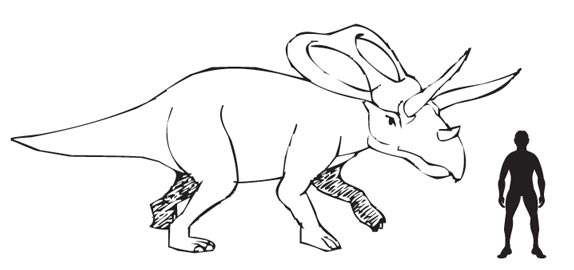Dinosaur Size Linked to their Lifestyle and Availability of Food
No sooner have papers been published suggesting that the body weights of dinosaurs may have been overestimated, a new report has just come out suggesting that dinosaurs got so big simply because the resources in their environment allowed them to do so.
Recently, the accepted methodology for estimating the mass of dinosaurs has been challenged. Heavyweight dinosaurs such as Apatosaurus and Diplodocus have had their estimated body weights reduced using a new mathematical formula. Now zoologists from the University of Florida have published research that indicates that dinosaurs were the “couch potatoes” of the Mesozoic.
To read the article challenging the accepted methods for calculating the weight of dinosaurs: Dinosaurs were “Thinosaurs” – A weighty issue.
Dr McNab and his team have argued that with easy access to abundant food and a sedentary lifestyle dinosaurs were able to grow into the biggest land living animals known in the fossil record. A number of theories have been put forward suggesting why dinosaurs were able to grow so big. For example, natural selection may have favoured bigger and bigger animals through predation pressure and the need to fight to secure a mate. Or being large may have helped dinosaurs regulate their body temperatures, as large animals with a greater surface area to body mass ratio are generally able to maintain a stable body temperature when compared to much smaller creatures.
However, the team from the University of Florida believe that it was the availability of food resources that was the most important factor.
Using a model based on a vertebrate’s energy use, expenditure, mass and eating habits, Dr McNab explained the body size of living and extinct mammals, including baleen whales, an ancient rhinoceros and modern elephants. He used the example of the larger mass found in some marine mammals which reflect greater resources in their environment. Developing his argument Dr McNab has stated that the dinosaurs were neither warm or cold-blooded but maintained a stable body temperature somewhere between the warm-blooded mammals and the cold-blooded reptiles of today, thanks to their enormous size.
While Dr McNab said that thermal biology differences are easily seen in small organisms, he suggested dinosaurs were neither cold nor warm blooded but maintained an intermediate temperature between mammals and reptiles, thanks to their size.
According to the American team, herbivorous dinosaurs grew large as their diet of plants was very edible, with later types of dinosaur benefiting from the development of flowering plants (angiosperms) and fruit. The paper is published in the scientific journal “The Proceedings of the National Academy of Sciences”.
Dr McNab commented:
“Like couch potatoes sitting within easy reach of high calorie foods, the gargantuan size of dinosaurs most likely stems from the abundance of resources available, coupled with low energy expenditures. Some dinosaurs reached masses that were at least eight times those of the largest, ecologically equivalent terrestrial mammals”.
A Scale Drawing of a Herbivorous Dinosaur – Torosaurus

Picture credit: Everything Dinosaur
The picture shows an approximate size comparison between a person and a Late Cretaceous herbivorous horned dinosaur, a Torosaurus, a close relative of Triceratops. Could access to lots of plants including fruit have helped these dinosaurs grow so big?
Dr McNab went onto state:
“The factors most responsible for setting the maximal body size of vertebrates are resource quality and quantity, as modified by the mobility of the consumer, and the vertebrate’s rate of energy expenditure”.
This new report is certainly going to raise one or two eyebrows, when extant types of fern and conifer are studied it is clear that they are difficult to digest and lacking in nutrients. Even angiosperms quickly evolved toxins and other defences to protect themselves from the ravages of large herbivores. Having to eat particularly difficult to digest food may be a reason in itself why dinosaurs grew so big. Herbivores needed a huge digestive system to cope with such a diet and the carnivores grew big too, as their prey got gradually bigger and bigger – a sort of plant-eater/meat-eater arms race.
Visit Everything Dinosaur’s website: Everything Dinosaur.






Leave A Comment